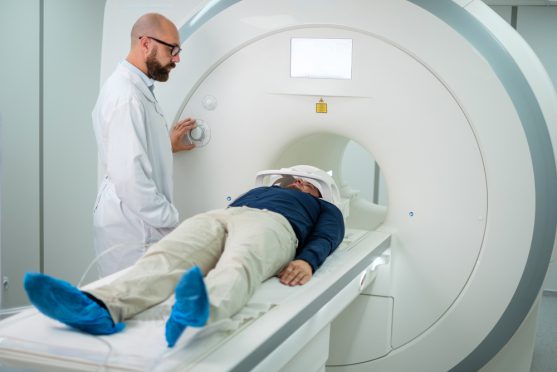Magnetic Resonance Imaging (MRI) is a type of scan that uses a magnetic field and radio waves to produce detailed images of the organs and tissues in your body.
It can capture images of different parts of the body including:
- Brain and spine
- Heart and blood vessels
- Breasts
- Bones and joints
- Internal organs like uterus, prostate etc
How does an MRI scan help a cancer patient?
Your oncologist might use an MRI scan for one or more of the below reasons:
- to find the location of a tumour in your body
- To find out the size of tumour and whether it has spread (helps to stage a cancer)
- To know if a tumour is cancerous or not
- To check whether treatment is working or not.
Based on the above information, your oncologist can plan the next steps of your cancer treatment.

Preparing for an MRI scan
- Usually, you can eat, drink and take your regular medications on the day of your MRI scan, unless you have been advised otherwise by your doctor. In some cases, they may advise you not to eat anything four hours before the scan. It will be best to check with your doctor about this.
- If you have any metal implants or a pacemaker, it’s very important you let the radiographer know before the procedure.
- You can inform them of any allergies or medical conditions you have.
- If you could be pregnant, let them know beforehand.
- Avoid wearing clothing with metal zippers or buttons. This includes inner wear with wires or hooks. You will have to remove these if they interfere with the scan.
- Wear loose fitted clothes.
- Avoid wearing any jewellery as you may be asked to remove them.
- Keep your face mask and hand sanitizer handy to protect yourself from infections.
What happens during an MRI?
- You will be asked to lie down on your back on a table. The table is then moved into an MRI machine. You will be required to lie still. Any movements can cause blurred images and the process will have to be repeated.
- You might have an injection of a dye (contrast medium) through an IV line. It might cause a metallic taste in your mouth. It might also give you a temporary, mild headache or a stomach upset.
- If you are claustrophobic or unable to stay still, you may be given medicine to relax before the procedure starts.
- It usually takes upto 30 to 90 minutes for the MRI scan to be completed. During this time you will hear loud noises from the machine. You will be given earplugs or headphones to reduce the effect of the noise from the machine.
- During this process, the technician will not be present in the same room, but will be able to communicate with you through an intercom service. You can also speak to them through this system if need be. They will be able to see you on a television monitor.
- You may be asked to stay back for about 15 minutes after the scan to ensure that you are not facing any side-effects of the dye like nausea or dizziness. This time also allows the technician to check if all the images have been captured clearly.
- Once you are allowed to leave, you can resume eating and other activities as usual.
Is an MRI painful?
No, MRIs are not painful.
Some people who are scared of closed spaces might panic during an MRI.
The MRI machine can be loud. This might cause a bit of discomfort but most patients are able to tolerate it.
If you suffer from extreme anxiety before such scans or diagnostic tests, you can use some relaxation tips from our article on scanxiety.
Is a CT scan the same as an MRI scan?
Although a CT scan and an MRI can be used for the same purpose in some cases, they are not the same thing. A CT scan uses X-rays to capture images, while an MRI uses magnets and radio waves.
A CT scan is more widely used and is less expensive than an MRI.
Sometimes, doctors prescribe an MRI scan when the CT scan is unable to provide the required amount of information.
In some types of cancer, like the brain, spinal cord or cervix, an MRI is preferred to a CT scan as it can produce clearer results than a CT scan. Basically, they are better in characterizing any soft tissue lesion.
You can read about preparing for a PET scan here.
